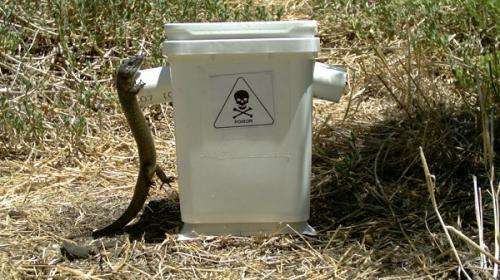Clever design sees rats disappear and native fauna flourish

Black rat numbers on Penguin Island have declined significantly while penguins and other native animals are flourishing, thanks to a baiting system that was introduced on the island one year ago.
Department of Parks and Wildlife (DPaW) researcher Karen Bettink says although it will be two years before eradication of rats can be declared, the system has been a success, with rat numbers reduced from several thousand to none being recorded for six months.
"Black rats can be devastating to island ecosystems, consuming anything from seeds, fruits, refuse, reptiles, eggs, vegetation and invertebrates, to birds and small mammals," Ms Bettink says.
"There had been marked declines in penguin breeding since 2010 and while this is in part attributable to food availability, undoubtedly black rats had a serious impact on eggs, chicks, fledglings and adult birds.
"The island's high environmental, scientific and social values were at significant risk so we decided to employ a baiting system which had been successfully used on other offshore islands in the Kimberley and eastern states."
DPaW scientists designed bait stations to reduce the amount of toxin required, protect baits from weather and exclude non-target species.
"They were designed to exclusively lure black rats into the high holes of the stations, however, during the testing phase, we found king's skinks were excellent climbers and were also accessing into the holes," Ms Bettink says.
After modifications to the stations were made, including hole heights, diameters, and adding PVC sleeves, the review of footage from remote cameras showed skinks were unable to balance on their tails and bend backwards to gain access.
Three hundred and fifty bait stations were placed across the island at 20m intervals. Five full baitings were required to successfully eradicate the rats with the last full baiting in March 2013.
"Since then, no rat-related injuries to penguins or chicks have been recorded and while we are still collecting data, early estimates show their numbers are improving," Ms Bettink says.
"One year ago, there were no bridle tern fledglings, but they are now a common sight."
"Monitoring data has shown an eight-fold increase in buff-banded rails and greater numbers of crested tern fledglings and small reptiles, including fence skinks and marbled geckos."
"There is a suite of juvenile and adult king's skinks remaining which will see the population recover."
Permanent surveillance cameras now regularly monitor for rat activity. In conjunction with other research, scientists also undertake biannual trapping and monitoring.
Provided by Science Network WA



















